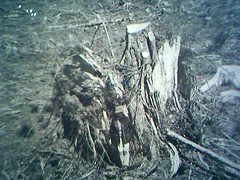I'd never heard of Robert Adams before I saw his show at SFMOMA. Called "Turning Back," the photos document the destruction of the old-growth forests that Lewis & Clark passed through on their journey westward. The title refers to the implications and complications of westward advancement. When Lewis and Clark reached the West Coast, they turned back and headed east; the vast devastation in Adams's photos conveys the sense that — these days — there's no turning back."Turning Back" is bound to strike a chord with people. It evokes indelible American ideals and icons — the natural beauty of America, the promise inherent in the West, the bravery of Lewis & Clark — and presents it in a format and style eerily reminscent to another photographer named Adams — Ansel. Whereas Ansel's classic photos endeavor to communicate the vastness and beauty of America, the best of Robert's manage to convey an equally vast devastation.While I walked through the show, I thought a lot about my hike on the PCT, which took me through a few of the same forests featured in the show. As I approached the northern part of the west coast, I was pretty curious about the clear cuts. Of course I knew that it would be depressing, but really I had no idea what to expect. I imagined a sort of Lorax‑y landscape of smooth hills dotted with little stumps.As I hiked through the vast clear cuts of Northern California, Oregon and Washington, I was stunned *not* by the absence of trees, but the obvious brutality surrounding their removal. In the newer clear-cut areas, there was upturned earth everywhere, huge mounds of soil, mangled stumps — I've never been on a battlefield, but there's probably more a few similarities between the two. In some places, the dirt mounds and fallen trees completely obliterated the trail, and we had to do some pretty thorough route-finding before we made it through.In the areas that had been clear-cut years before, the trees grew in thick clumps. One didn't so much hike through them as swim, or claw, or climb. The small trees were themselves fighting for space, and their branches were so densely interwoven that the ground was invisible for hundreds of yards around. In the mornings, before the dew evaporated, one could easily get soaked in the space of twenty yards while pushing through the branches.Adams's photos convey the brutality and upheaval well, though I really wished that context had been provided along with each photo — where was it taken? when? what used to be there? I wanted to connect with specifics of geography and fit the pieces together.
Categories
